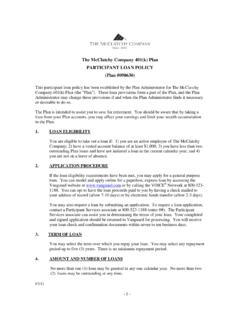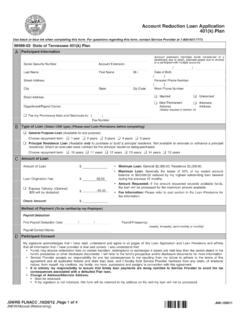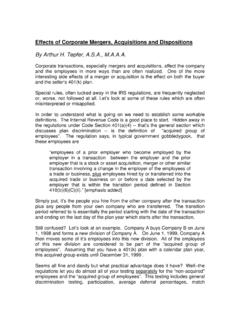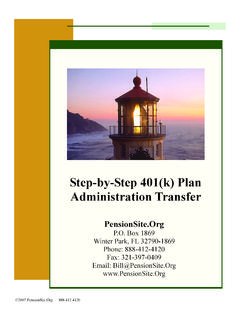Transcription of 401(k) Matching Contributions — Management’s Options
1 2 Owner-only 401(k) Plans A NewOpportunity34 Don t Overlook Top-heavy RegulationsFinal Loan RegulationsInside401(k) Matching Contributions Management s OptionsSITUATION: company A matches itsemployees 401(k) Contributions 50 centson the dollar on the first 4% of wants to consider othercontribution :What other types ofmatching and contribution formulas areavailable? ANSWER:A 401(k) plan sponsor has awide range of Matching possibilities fixed or discretionary, or a combinationof the two, or even no :With a fixed match, thecompany simply chooses to match a fixed percentage of an employee s plancontributions.
2 Many plans have a singlematching formula. The plan matches apercentage of each dollar that an employ-ee contributes (most often either 50 centsor one dollar on each employee dollar)up to a specified percentage of pay. Otherplans offer a two-tier match dollar for dollar up to a certain percentage ofpay and less than a dollar for additionalamounts, again within a specified per-centage of pay. With a discretionarymatch, the company determines its contribution amount annually, usuallybased on tax law limits the annual additionsthat may be made to an employee s 401(k) Benchmarking Survey*offer a matchingcontribution.
3 About half (47%) beginmatching within the first three months of service 26% immediately after hir-ing. Fixed match formulas are dominant;83% of the companies that match theiremployees Contributions have a fixedmatch. Only 11% use a discretionary formula. The remaining 6% of the planshave a combination of fixed and discre-tionary the plans with matches, 73% use asingle Matching formula, 5% have differentformulas for two employee groups, and13% use tiered contribution plans usually match a small part(continued on page 2)or other defined contribution retirementplan account. This year, the maximum isthe lesser of 100% of compensation or$40,000.
4 Employers may deduct contri-butions of up to 25% of compensation(not counting 401(k) elective deferrals).Within these overall constraints, thematching formula, if any, is the plansponsor s decision. (Note, however, that a 401(k) plan may not discriminate infavor of higher compensated employees.)When considering Matching contribu-tions, it may be useful to examine thechoices other companies have than 85% of the 401(k) plansresponding to the 2002 Annual 401(k) spring 2003Do you run your own business alone orwith a partner but without the help of other employees? If so, new tax rulesmay make it beneficial for you to start a401(k) plan .
5 Similarly, if you already havea profit sharing plan , adding a 401(k) salary deferral feature to your existingplan may allow you to set aside moremoney for your retirement on a tax-deferred SalaryWith a 401(k) plan , you elect to set asidea portion of your annual 2003, the tax law allows you to defer as much as $12,000 of compensation $14,000 if you are age 50 or over. Theseannual deferral limits are scheduled toincrease to $15,000 and $20,000 by are not taxed on the deferrals, or onOwner-only 401(k) Plans A New Opportunity2plan investment earnings, until youreceive distributions from the plan .
6 Yourbusiness deducts the deferred compensa-tion as an MoreThat s not all the law allows, your discretion, the business also canmake additionaltax-deductible profitsharing Contributions to the plan on yourbehalf. (Total annual additions to youraccount are limited to $40,000. Otherlimits apply.) The combination of yourannual 401(k) deferral, your company sprofit sharing Contributions , and planinvestment earnings could result in a sizable nest egg by the time you your spouse works in your business,note that he or she would be able to participate in the plan as (k) MatchingContributions Management s Options (continued from page 1)of pay at 100% or another very highlevel and a larger part at a much lowerlevel.
7 This type of formula effectivelyencourages enrollment, but requirescontinuing effort to raise contributionsabove the generous first Ways Plans Determine Contributions (401(k) and combined 401(k)/profit sharing plans)Method% of Plans UsingFixed match only (excluding safe harbor) .. match and discretionary profit sharing match only .. profit sharing match only .. profit sharing match and other Contributions .. harbor match only .. match and other Contributions .. profit sharing contribution only .. match and discretionary profit sharing contribution only .. company contribution.
8 Percentage of participants pay only .. percentage of profits only .. profit sharing contribution and other Contributions .. : 45th Annual Survey of Profit Sharing and 401(k) Plans,Profit Sharing/401(k) Council of AmericaSimilarly, the Profit Sharing/ 401(k) Council of America s 45th Annual Surveyof Profit Sharing and 401(k) Plans**found the most popular Matching for-mula to be 50 cents on the dollar. Nearlyhalf ( ) of the plans surveyed useda 50% match, with 26% of these plansmatching up to 6% of employees of the plans surveyed matchless than 25 cents on the dollar; 23% usea dollar for dollar :The Matching choices ofother companies can be useful input indetermining an appropriate companymatch.
9 However, a plan sponsor mustbalance both company and employeeneeds within the context of the compa-ny s financial situation. A knowledgeableoutsider s perspective may be helpful. Ifyou want assistance with your matchingdecision, please talk with your employeebenefits professional.*Conducted by Deloitte & Touche**Available online at by calling 312-441-8550 SITUATION:When company X wasestablishing its 401(k) plan , one of thefeatures that appealed most to the com- pany s CEO was the flexibility a 401(k) plan offers in terms of company contri-butions. After some analysis, company Xdecided to match employee salary defer-rals up to 2% of pay.
10 During the plan sfourth year of operation, however, theCEO learned that company X wouldhave to make an extra contribution tosome of its employees accounts in orderto comply with tax law :Why would a plan suddenlybecome subject to a minimum contribu-tion requirement? ANSWER:The company X plan became top heavy. The sponsor of a top-heavy401(k) plan generally must contribute atleast 3% of compensation on behalf ofnonkey employees. The rules also call forthe use of a specific minimum :A tax-qualified retire-ment plan must include provisions thattake effect whenever the plan becomes topheavy.










